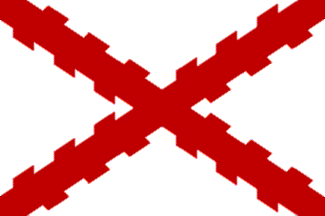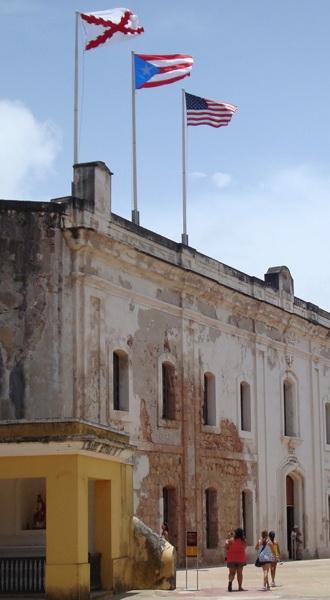
image by Blas Delgado Ortiz, 4 March 2000

Last modified: 2021-08-25 by rob raeside
Keywords: puerto rico | burgundy cross | cross (burgundy) |
Links: FOTW homepage |
search |
disclaimer and copyright |
write us |
mirrors

image by Blas Delgado Ortiz, 4 March 2000
See also:
Some friends who were in Puerto Rico over Christmas described
a commonly seen flag (along with the Stars and Stripes and the
Puerto Rican flags): The flag is a St. Patrick's cross, red on
white, but the cross is made of 9 "bricks" on each
diagonal, instead of being a single straight-edged band. (This is
a crude gif.)
Rob Raeside, 20 January 1998
This is the "Cross of Burgundy," one of the
standards of Spain that was used by the Spanish Military in the
South East US.
Nathan Bliss, 20 January 1998
It's not the usual Cross of Burgundy. This is "argent,
gnarled cross gules", but the one that was flown in Puerto
Rico was definitely a cross made of horizontal
"bricks". It was flying at El Morro, an old fort in San
Juan.
Rob Raeside, 21 January 1998
The "Cross of Burgundy" flag is the Spanish military
flag. My understanding is that is was not used after the 1780's.
It is flown over San Cristobal fort, El Morro fort, and some
other buildings that were official buildings under Spain as an
historical thing. The cross does not reach the corners.
Anna Stone Jimanez, 31 October 1998
I saw your webpage on Puerto Rican flags and I would like to
clarify something about the "Cross of Burgundy" Flag.
This flag is not the "Cross of Burgundy" but "La
bandera de San Andres de la Infanteria." translated
"The flag of St. Andrew of the Infantry." St. Andrew is
the patron saint of the Spanish Armed Forces (Even to this day.)
The White and Red flaming cross represents the colors of "El
Tercio de Nueva España". This regiment became the 29th
local infantry regiment that saw action in the British invasion
of Puerto Rico in 1798, The Spanish-French war of 1809, The war
of 1812 in Louisiana under the command of Bernardo de Galves and
the Spanish-American War of 1898, where the regiment was
disbanded after the conflict ended in favor of the U.S. The Flag
is still flown at San Felipe del Morro Castle in San Juan as a
tribute to this regiment.
Marcos Rodri'guez , 1 October 1999
The basic pattern of a "saltire raguly couped
Gules", or plainly speaking a red saltire resembling two
crossed, roughly-pruned branches, on a usually white field (but
also blue, purpure etc.), was the Spanish military flag from the
15th century up to 1843, when the red-2 yellow-red ensign was
adopted for use on land too. The saltire was originally a
Burgundian emblem, first introduced in Spain as the personal
badge of Phillip the Handsome, Duke of Burgundy and King Consort
of Castile and Aragon, married to Joan of Castile and Aragon
(daughter of the Catholic Kings Ferdinand and Elizabeth), the
parents of Charles I (Charles V as German Emperor). As such, the
emblem has been called in Spain "cross [or, more properly,
saltire] of Burgundy", even if the term "cross/saltire
of St. Andrew" has also been used. To say that the flag is
that of the Spanish armed forces "because" its patron
saint is Saint Andrew, is a post-facto explanation with not much
vexillological background. Spanish infantry did fly it, as also
did cavalry, artillery, engineers, etc. It was first used not by
regular infantry but by the equivalent to the present Spanish
[Foreign] Legion, the "Tercios", volunteer
expeditionary troops including infantry and cavalry. From the
1930s up to recently there has been scarce use of the Burgundy
Cross by infantry units in flags, uniforms etc., whereas it is
displayed in all Spanish Air Force planes (that is what the
stylized saltire fin marking stands for!). On the other hand, it
is a mistaken explanation, since the patron saint of the Spanish
Infantry is not St. Andrew but Our Lady's Immaculate Conception!
Actually none of the Spanish Armed Forces' branches-of-service
have St. Andrew as its patron... The Burgundy Cross is
nevertheless related to St. Andrew indeed, not through the
patronage of a Spanish army branch, but through its Burgundian
origin - St. Andrew being the patron saint of the Duchy of
Burgundy.
Santiago Dotor, 6 October 1999
The white flag with the red cross flown in the forts in P.R.
is in fact "La Cruz de Borgoña" or Burgundy Cross also
known as "La Cruz de San Andrés" or St. Andrews Cross.
The "brick" pattern is due to the cross having knobs.
It has been a historical battle standard in Spain for ages.
Jorge D. Gonzalez, 13 October 1999
Flags having this cross with many minor variations were the
most common symbol for Burgundy in the late middle ages,
sometimes with a white field and sometimes with any of a wide
variety of colored and multicolored fields. It also appears, less
frequently, with a white cross on a red field. With the union of
the Burgundian and Spanish crowns under Phillip the Fair, it
became (again with many variations) a flag of the Spanish
Netherlands (present-day Belgium) and of the Spanish crown and
military forces. I have seen flags in old flag charts as
"Ostend" and "Biscay" and a wide variety of
them are illustrated in Perez and Gonzales, Banderas de España,
1983. with dates as early as 1520 and as late as 1931, frequently
as unit flags which then usually have a badge or name of the unit
as well).
Norman Martin, 27 January 2000
Over the summer, I visited Puerto Rico. At El Morro, I noticed
an unusual flag flying over
the fort and asked a Park Ranger about it. He said it was the
Spanish military flag that flew over the fort in the 16th and
17th centuries. I bought a little 4x6 inch version of the
flag for my office. The flag you currently have on your webpage
for the "Burgundy Cross" is similar but not quite
right. The color is darker and it's not really the right
shape. Here is my little flag.
Chris Gleason, 28 January 2000
I figure that, from afar, perhaps on a picture, the cross
might look like the arrangement with "bricks" which
seems to pose as the Burgundy cross. Actually, I saw something
like that on a TV special.
Guillermo Tell, 31 January 2000
This "brick arrangement" must certainly be an
optical effect. Many variants of the Burgundy cross existed, but
all the variations consisted in either (a) the saltire being
'throughout' or 'couped' i.e. reaching or not the borders, (b)
the total number of 'stumps' on each of the saltire's arms
(including no 'stumps' at all), (c) the number of 'stumps' being
identical or not on each side of the saltire's arms, (d) the
'stumps' ending with a cut parallel to the saltire's arm or with
a right-angle cut, (e) the 'stumps' being of the same width as
the saltire's arms or thinner, (f) the colours of the saltire and
the field (mostly red on white, but also red on yellow, white on
blue, red on purple etc.) or (g) the saltire being represented as
a heraldic 'saltire raguly' or more realistically like two
branches, sometimes even joined with a ribbon.
Santiago Dotor, 31 January 2000
The Cross of Burgundy or St. Andrew Flag also flies in the Castillo
San Cristo'bal, or St. Christopher Fortress, in Old San Juan.
This is a bigger but less known complex than El Morro, built by
the Spaniards. It isn't in its original state. Both fortresses
are administered by the U.S. National Parks Service. The flag has
the same 2:3 dimension as the PR National Flag.
Blas Delgado Ortiz, 4 March 2000
Those of us above a certain age recall that the fort's colors
*used* to have the saltire "couped" i.e. not stretching
all the way to the corners, and "ragouly" i.e.
irregular. As time went, the saltire became more and more
stylized so that as of the late 1990s the pattern is
the one at the top of the page, though historicaly it would be
incorrect.
Jose Diaz, 29 September 2000

image taken by Ben Cahoon, 25 August 2011
At Fort San Cristobal in San Juan, Puerto Rico I saw the National Park
Service was flying the pre-1701 flag of the Spanish monarchy with the Burgundian
cross. I thought this was very interesting as it is being flown on the forts
walls along with the U.S. flag and the flag of Puerto Rico (attached image taken
by me).
Ben Cahoon, 25 August 2011




